RETAIL FURNITURE HERITAGE 1800-2011
by Janet Holt-Johnstone
It was 1911, an extraordinary year of discovery and upheaval. In China, Sun Yat-Sen overthrew the Manchu Dynasty. Another revolution in not-so-far-away Mexico saw President Porfirio Diaz replaced by Francesco Madero. Visionary Roald Amundsen became the first man to reach the South Pole. The ancient Incan city of Machu Picchu was revealed to the world by American explorer Hiram Bingham. And Marie Curie became the Nobel Prize winner in Chemistry for her radium and polonium breakthrough.
Long's Bedding & Interiors
Simultaneously, Harlem, New York, was impacted by the arrival of Max Long from Poland! Max was part of the major westward migration of European peoples, entrepreneurs many of them, who entered the American marketplace and fought their way to success. His grandson, Bob Long, now President of Long’s Bedding & Interiors, told us the story.
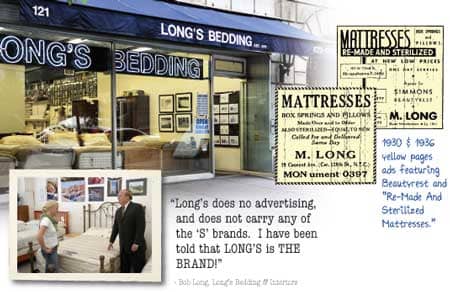
“Max manufactured and renovated horsehair mattresses and, in due time, his sons Harry and Irving joined him in the business. A couple of years later, with an initial investment of $500 each, they opened Larry’s Bedding on West 72nd Street, although Irving continued to work with his father. In spite of Harry’s dedication and hard work, in a year’s time the business was failing. Harry went to Max for an early ‘stimulus package’. In the spirit of tough love, Max said, ‘If you can’t make it, close the store!’
“But shortly after, the War started, the Great Depression began to fade, business improved and Harry (my dad) bought out Max and Irving!
“Fast forward to 1963. I flunked out of the University of Wisconsin, and my dad offered to take me in; I was 20 years old.” (He began his personal career history on the delivery truck.) ”I started at $75.00 a week. One year later, I asked for a raise as I was getting married. I received a $15.00 raise, and was not too happy! Went to my dad and expressed my unhappiness. He said if you think you can make more elsewhere, go! He had a partner at the time, and did not want to take advantage. (P.S., one week later, he gave me $20.00 more each week out of his own pocket!)
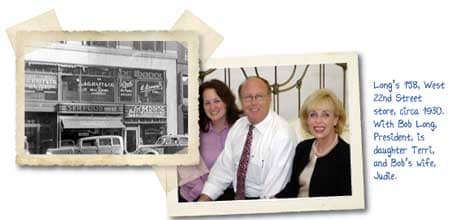
“In the mid-1980s, my wife, Judie, came to work as a bookkeeper, and very swiftly became a sales person! In the late 1900s, after graduating from Ohio State University, my youngest daughter, Terri, came to work as my bookkeeper, and she very swiftly became my right and left arms.”
Long’s Bedding has had both eureka and insightful moments over the decades. Said Bob, “My dad had a small warehouse in Harlem, not a lot of stock. In the late ‘60s, I opened a large warehouse, 10 times the size of the original. This enabled me to make quick deliveries as I stocked all beds in all sizes. In ’72, I bought a small business that dealt with interior decorators for a very small tag. This turned out fantastic as there were hundreds of live customers. Today, I still have many of them.”
Bob feels that “today is quite challenging in lieu of our economy the past three years, and the world with all its problems. Up until 2008, every year was a growth year and Long’s did very well. I have had to make many adjustments; however, we are still surviving and paying our bills promptly.
“Long’s does no advertising, and does not carry any of the ‘S’ brands. I have been told that LONG’S is THE BRAND!” An article reprinted in Long’s website confirms that, “People come to Long’s Bedding not to buy an ‘S’ brand, but to buy our integrity.
“That’s not to say that Long’s doesn’t have some strong bedding brands in its stable . . . The lineup does include an ‘S’ brand, Simmons, and also carries bedding by Aireloom, Therapedic and Englander.
“It also has its own bedding line, Long’s Landmark, designed by the Long family.”
Bob continued, “I have a very educated and friendly staff who do not push but have the knowledge to explain differences in qualities and construction of beds. All beds are stocked in all sizes and can be delivered within hours. I have my own two trucks and my delivery men have been with me some for over 20 years. The delivery men are the last touch with the customer and it is most important that the delivery ends on a good note.
“About five years ago, I started importing beds from RELYON Manufacturing from Somerset, England. These are the finest beds made in the world and they are all stocked in my warehouse.”
Long’s has been described as, “Bedding purveyors to the rich and famous” from its prime strategic location on Manhattan’s Upper West Side. Renowned interior designer Steven Gambrel is a fan, as were John Lennon and former president, John Kennedy. Also on Long’s client lists are Jerry Seinfeld, Steve Martin, Carly Simon, Matt Lauer, Connie Chung and Diane Sawyer.
Mick Jagger was a tad unique when he ordered a wall-to-wall mattress for his bedroom, just one more successful project. Revlon’s Chairman, Ron Perelman, requested extra-firm custom-made mattresses for his 10 homes, plus another, immediately, for his hotel room in Los Angeles. Not in the least dismayed, Bob found a trucker to drive the mattress cross-country to the hotel.
Long’s website text can be forthright and pithy. Speaking to new college graduates, establishing their first homes, Bob says, “Tell your futon to kiss your done-with-dorm-life ass good-bye and get a grown-up bed!”
After nearly a century of service in what has often been described as “the toughest retail market in the country”, Long’s knows that they’re “good in bed”! See www.longsbedding.com.
Verbarg’s Furniture
Meanwhile, west of Manhattan in Cincinnati, poet Longfellow’s “Queen City”, third largest community in the State of Ohio, a gentleman, his wife and five daughters, endowed with determinedly optimistic philosophies, adopted a motto that reflected their convictions, “Fine furniture with superb craftsmanship never goes out of style!” Harold Verbarg has been a believer since he was 15 years old, working as a finisher, then cabinetmaker, at The Early American Shop.
His youngest daughter, Sheri, now in charge of both marketing and floor design for Verbarg’s, also writes “Interior Motives” for their excellent website. She painted a warm family portrait for us, illuminating the past six decades.
“In 1956, my father broadened his horizons when he left The Early American Shop to work at Colonial Woodcraft, also in Cincinnati, where he not only made furniture, but sold it as well. He stayed until 1964, then returned to The Early American Shop, at one point renamed W. B. Meier Furniture. In 1967, he was promoted to the positions of President and Manager. He remained there until 1977 when Mr. Meier sold his business.”
But behind the scenes, the entrepreneurial spirit was stirring. “Mr. Meier also owned a closeout centre east of Cincinnati which my parents were interested in purchasing. In 1978, Harold and Shirley Verbarg bought the closeout centre from Mr. Meier and opened their own business. They named the new enterprise Verbargs American Heritage Furniture. Mr. Meier laughed and prophesied, ‘You will never make it out there in the country!’
“And I will never forget how bad the store looked on that January day,” Sheri reminisced, “the first day of January, cold and snowy, 29 degrees. The store was old and dusty, and my Mom cried as we cut the celebratory cake. Store traffic was negligible, but one customer bought a recliner! The first year was rough with my Dad buying, selling and delivering the furniture with the help of one employee, Ralph Flynn, and family members pitching in when they were available to help.”
From an article published in Best Magazine last year we learned that “Shirley and Harold had raked together $15,000 to open the store, so there was nothing much left but each other. But that was enough. The year ended with sales just over $300,000.”
Said Sheri, “My parents built their business on the premise of offering the finest furniture at a fair price with impeccable customer service to all of their friends in the greater Cincinnati area. Some of the original manufacturers initially offered at Verbargs were North Hickory, Cresent, Temple Stuart, Hitchcock, C.R. Laine and Hickory Chair. Soon Verbargs was the place to shop in Cincinnati for fine furniture and accessories.”
Best Magazine continued, “This Mom and Pop operation expanded over the years as nearly every dollar earned over expenses went into the facilities and new products. Improvements included adding a 7,000 square foot warehouse, meaning that the store doubled in size. Ten years after their start, they opened a store in Sharonville.”
Sheri said, “This just happened to be the facility where Dad had worked when he was younger, the former Colonial Woodcraft. Then, in 1996, the Verbargs decided to move from our Sharonville location to a much larger building in Cincinnati, once again, surprisingly, the site where my father worked previously, the former W. B. Meier Furniture store! Today we continue to prosper there and our original store in Amelia is currently our Outlet store.
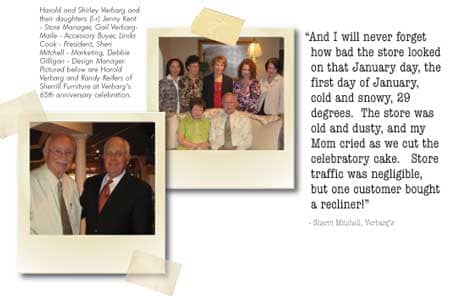
“Today, Verbargs is the exclusive Stickley dealer in the Greater Cincinnati area. We offer Stickley furniture and many other fine companies such as American Leather, Hancock and Moore, Harden, Henkel Harris, Sherril, Theodore Alexander, Taylor King, Jamison, The Custom Shoppe and, still, C. R. Laine, just to name a few.
“Harold turned 80 this past December, and has been making and selling furniture now for over 65 years. He was able, with the continued support of his wife Shirley and his five daughters, to take an old store that others thought wouldn’t make it and turn it into the premier furniture store in Cincinnati, Ohio. Harold is still working along with all five of his daughters to bring only the best to the furniture buyers of Southern Ohio.”
When asked about Verbargs’ “competitive edge”, she replied, “It’s the service we provide. Harold continues to go out on service calls to his customers because he believes in a ‘hands on’ approach to his business. Verbargs also stands behind our products above and beyond what is normally warrantied. Harold tells a story of not too long ago. One of our past customers had purchased a Cresent bed from us back in 1989; one of the rails had broken. We fixed the bed rail free of charge. This is a common practice for us, and Harold believes strongly that service is of utmost importance.
“I believe that when my Dad first started this business, he also believed in fair pricing and, because of this, people drove out to our store in the country. It was his plan to offer the best quality with fair prices and that inspired many of our customers to drive so far from the city.” Strength in belief.
In response to “a special time in the history of the operation”, Sheri said, “When Verbargs opened in 1978, it was during a major down swing in the economy. The opening of a furniture store in a not-so-good location would be our special time, because with hard work and Harold’s belief in a ‘hands on’ approach, we beat the odds. I think that right now is also a time in the history of our company that many can learn from in that we continue to emphasize quality instead of lowering our standards, even though the economy is rough. We also continue to service our customers in any way we can.
“And a ‘stand out’ issue is our commitment to American made companies. Verbargs strives to support as many American made companies as we can; we feel that not only ensures our success, but also benefits our customers as well as our country.”
Shirley deserves strong recognition. Quoting Best Magazine again, “She was there all along, working part-time in both the Amelia and Kenwood stores, raising her own family and taking care of her kids’ kids”.
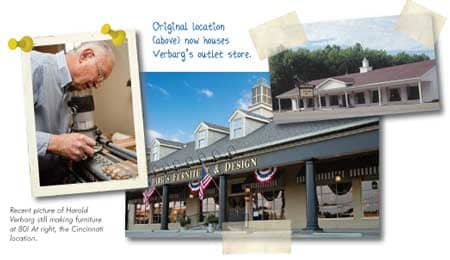
Daughters Linda, Jenny, Sheri, Debbie and Gail all worked at their parents’ stores from the time they graduated or after short stints in other jobs. “They just kind of wandered in and said, ‘Can we work, Mommy?’”, said Shirley. “No one forced them into it!”
Now every one of them holds a key job. Linda is president, Jenny vice president, Debbie a designer, Sheri an all-round marketer and designer, and Gail who handles lighting and accessories. Verbargs has 30 employees.
Marketing has been key to Verbargs’ strong visibility. Word of mouth, an accumulation of accolades over the years, television, radio, print, direct mail and event planning all make their contribution.
Harold and Shirley are eager for their 11 grandchildren and 13 great-grandchildren to follow them into the home furnishings industry if they’ve inherited their entrepreneurial spirit. Says Harold, “They’d have to have enough start-up capital; find a decent location; carry good lines of furniture and get experience working for someone in the business first.” Can’t think of anyone better than Harold and Shirley as mentors. Harold said that he’ll never retire!
Home Furniture
There was also a notable 20th century retail upheaval north of the U.S./Canada border, well worth recording, in similar time frame. But first let’s lay the groundwork. Originally known as Jakobstettel, a small community in southwestern Ontario was renamed St. Jacobs in 1852. The pluralization was in honour of the combined efforts of Jacob C. Snider and his son, Jacob C. Snider Jr., the pioneer founders of the village. The “St.” was added simply to make the name sound more pleasing. It’s a popular tourist destination now due to its Mennonite heritage and an enticing collection of boutique stores. And the meandering Conestogo River, which powered the first gristmill, runs through the village. Also, St. Jacobs is the headquarters of giant Home Hardware/Home Furniture.
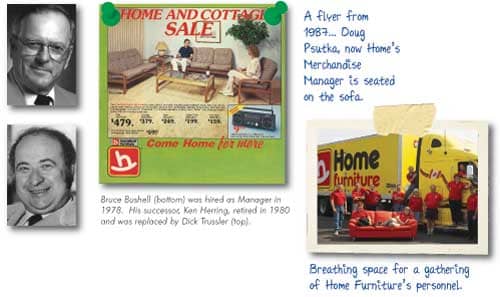
Walter J. Hachborn, one of Home’s founders, worked as a stock boy at Hollinger Hardware on St. Jacobs main street. The year was 1938 and his pay cheque was $8 a week. Ten years later when George Hollinger died, young Walter, after service in the Canadian Army during WWII, took over many of his mentor’s responsibilities. In 1950, he was able to buy the business, in partnership with Henry Sittler and Arthur Zilliax. Inspired by the need to address the urgent economic challenges of his fellow retailers and encouraged by the observed success of the concept in the United States, Walter spearheaded Home Hardware’s dealer-owned cooperative model. The dealer-owned network with centralized distribution was founded on January 1, 1964.
Over the years, in the gentle custody of many of Home’s people, there has been a collaborative effort at documentation of corporate history, a story they’ve shared with us.
“From the early days of Hollinger Hardware, the store in St. Jacobs always carried a line of furniture in addition to its hardware lines. This part of the operation was watched over and managed by Bruce Gavel. He was an avid supporter of Canadian-made products and purchased from manufacturers in Ontario and Quebec. If the item the consumer wanted was not on the retail floor, Bruce referred his customers to his huge counter catalogue, detailing the complete line of many suppliers. This was the way business was conducted in individual furniture retail stores in Ontario and Atlantic Canada.
“As the Home Hardware programme was developed, and hardware dealers became members, it was only natural that these hardware and furniture dealers should start thinking about bringing the same organizational benefits to those involved in furniture. Home management was encouraged to set up deals with furniture suppliers and soon major appliances were added to the product lines. It wasn’t easy when you considered that furniture manufacturers were selling directly to retailers with their own sales staff, and this left very little margin for a wholesaler or buying group to become involved. Freight was expensive because the product was bulky and relatively low weight, making it difficult to warehouse goods of this nature. The appliance industry was changing with the buy-out of Canadian firms to the U.S.A. and the amalgamation of major Canadian companies. Electronics such as televisions, VCRs, radio and stereo systems were suffering the same fate.
“It was obvious a buying group was needed to negotiate the best possible pricing for the dealers. Volume was a definite prerequisite to accomplishing this goal. Consequently, in 1970, the empty warehouse space on King Street in St. Jacobs was converted into a super retail furniture store that used the upper floors for warehousing. Home’s buyers attended the Toronto and Montreal furniture shows every year to get to know the suppliers.
“In 1978, the Home Board approved the formation of a furniture division and Bruce Bushell was hired as manager. The Home furniture division adopted a stylized rocking chair as its logo and used the name Homeland. In 1980, the new manager, Ken Herring, returned to furniture manufacturing after one year. His successor was Dick Trussler who had considerable expertise in major appliances. In 1984, Dick managed major appliances and Bruce Hammer assumed management of the furniture enterprise. Bruce had considerable experience from his years in his family furniture business. That same year, Morgan McCabe, who had managed the retail furniture store, became buyer.
“As business increased, the need for more warehouse space grew with it. When the service building was purchased in Elmira, the furniture division moved into it and a warehouse facility was set up. Furniture lines could now be purchased from the Far East and the U.S.A. and warehoused in Elmira. Dealers were still buying direct from Canadian sources. Full advertising and promotional programmes, including consumer catalogues, helped the furniture dealers reach their consumers.
“In 1992, the Homeland name was changed to Home Furniture to bring this division under the umbrella of Home Hardware Stores Limited along with all the others. It also reinforces its association with Home Hardware as many of the furniture businesses operate alongside the local Home Hardware store. The dealers support the programme and have been very successful.”
Bruce Hammer, General Manager believes Home’s mission statement is the company’s “competitive edge”. He said, “Home Furniture has always remained steadfast in its commitment and execution of its mission; ‘It is Home Furniture’s mission to supply its Dealers with quality products and services, to provide them with the programmes to operate efficient and profitable furniture stores and to assist them in serving the customer with competitive prices and superior services’. This focus is shared by all staff, and has serviced the company well over the years through prosperous times and challenging times.”
Home has celebrated many “special times”. In celebration of Home Hardware’s 40th anniversary, Canada Post actually produced a stamp commemorating the occasion, a rare happening. Then, in February 2000, President Emeritus, Walter Hachborn, received the Order of Canada. In 2007, he was again honoured with the Canada Lifetime Achievement Award by the Retail Council of Canada (RCC). And there were more: Citizen of the Year, Woolwich Township, 1978; Honourary L.L.D. Wilfrid Laurier University, October 1985; Distinguished Canadian Retailer of the Year, Retail Council of Canada, 1988; named to the Canadian hardware Housewares Hall of Fame, 1989; Master Entrepreneur of the Year, 1996; Retailer of the Century, Hardware Merchandising, December 1999; inducted into the Waterloo Hall of Fame, 2001; and the Queen’s Golden Jubilee Medal, June 2003.
We asked Bruce Hammer to tell us about the “one issue, cause or policy” that has ensured Home’s success. His answer, “The one issue that stands out among all others is Home’s decision to become their own Dealer owned wholesaler and eliminate the middleman. Reducing product costs and overhead expenses while flowing revenues into Dealer advertising and service programmes has been a formula that has seen few changes over the years. Home has not strayed from its humble beginnings to one of Canada’s largest retail organizations with retail sales of five billion dollars.”
Marketing Manager, Ryan Van Stralen, looks to the future. He said, “Roughly by the end of June 2011 we plan to have our entirely redesigned, feature-rich website live. The new site will enable pricing by store, the ability for consumers to add to a shopping list and share that list with friends via Facebook, Twitter, e-mail and a host of other methods. The new website will also feature more photography of products and the ability to zoom in on the details of those products. The biggest change will be the ease of searching for products. Consumers will be able to enter search terms with intelligent results returned, or navigate by quickly refining their search by category, material, colour, style, collection, function, if it is on sale, by newness or product, etc. Individual stores will have the ability to have their own micro-sites to highlight their own store information.
“We have launched national e-communications with our customers who can sign up in-store on our new website, or on our sister site, www.homehardware.ca.
“In late 2011 to early 2012, we plan to launch a mobile version of our new website.
“We have been exploring the use of social media, and have some dealers engaged in Facebook.
“Towards the end of 2011 and into 2012, our frequency of message out to consumers will increase. Our vehicles will include national furniture and appliance flyers, local e-mail communications, and store event nights. All of these vehicles are supported by channel assets for radio, newspaper, in-store POP, social media, on-line advertising and direct mail.
“From a category perspective, all national ads, in addition to furniture, now also feature appliances (a growth category for us) as well as mattresses, so that customers can see the destination shopping experience our stores can offer.
“For 2012, the formats of some of our national advertising vehicles will change, and they will be echoed on-line as e-flyers and catalogues both on our own site and Flyerland.ca.
“We launched for 2011, a collection called ‘Luxury Living’, that highlights our higher-end offerings.
“Through the website and advertising, we will be focusing on letting customers know that they are able to custom design many of our products.”
Promotions are offered frequently to consumers, Aeroplan miles on all purchases, up to $10,000 on purchases in featured contests and cross-promotions, and much shared information through Bev Bell, Creative Director with Beauti-Tone Paint and Home Product’s Division. Home Hardware publishes a magazine titled “Home at Home”, and Bev’s projects and ideas are a regular feature. “It’s more of a lifestyle magazine,” said Ryan. Bev was involved this summer in an ambitious scheme featuring Simon Chang, top Canadian fashion designer. The Beauti-Makeover with Simon Chang Sweepstakes awarded the grand prize winner with a décor makeover for a room in her home, and a trip to Montreal for a Simon Chang makeover for herself. “Great hair, great make-up, great clothes, great colour and great furniture – what more could any woman want!” Entries were available at Home Hardware paint sections. The contest was labeled as, “a meeting of the minds (and products) from three fashionable Canadian icons: Beauti-Tone Paints, Home Furniture and women’s fashion designer, Simon Chang.”
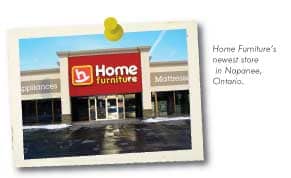
Check Home’s really interesting website (www.homehardware.ca) and you’ll discover all kinds of project angles from Bev, amongst them “Understated Elegance”, “Night Life”, “Lumber Party”, “Sitting Pretty” and “Knotty but Nice”. They are DIY ideas presented clearly, concisely and with an overtone of fun. All furnishings and supplies, of course, are readily available at Home Furniture/ Home Hardware!
You’ll also find input from Anna Olson, Home’s kitchen expert, best-selling author of six cookbooks, host of the national cooking show “Fresh with Anna Olson”, on Food Network Canada. The connection with both “Homes” shines bright.
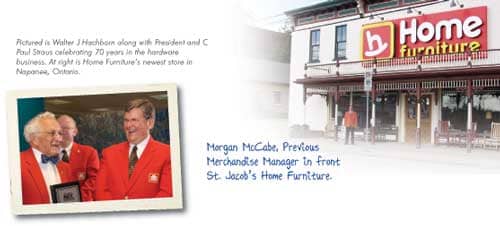
And out to the garden with Mark Cullen, working hand-in-hand with Home! Canada’s best known gardening personality, Mark’s expertise places him as Home’s horticultural spokesperson. A best-selling author with over 400,000 books in print, Mark reaches out to a huge demographic all with needs that include everything from outdoor furniture to gardening implements.
Home is well integrated into all the communities where their more than 1,000 outlets are based. Recently Home Dealers involved themselves abroad in a school building project in Mexico donating much of the necessary material, and building washrooms, a new office for teachers and planting trees along the exterior of the building to provide students with much needed shade. In Canada, they support sports teams and events, Toronto’s famous Sick Kid’s Hospital Foundation, Tree Canada planting and caring for trees across the nation, and Special Olympics.
Walter Hochborn’s vision was far reaching and has inspired thousands over the course of his distinguished career. His leadership tradition is now in the hands of Paul Straus, a long-time employee, now President and CEO. The company’s current advertising slogan is, “Home owners helping home owners”.
Next Issue: More retail histories from Furniture World readers.